| Wednesday, December 6, 2006 |  |
|
|
|
US Dept. of Energy: ...with DOE funding, a concentrator solar cell produced by Boeing-Spectrolab has recently achieved a world-record conversion efficiency of 40.7 percent, establishing a new milestone in sunlight-to-electricity performance. This breakthrough may lead to systems with an installation cost of only $3 per watt, producing electricity at a cost of 8-10 cents per kilowatt/hour, making solar electricity a more cost-competitive and integral part of our nation’s energy mix. That's very good news. But there's something kind of perverted about converting it to a cost per kWh, as if that makes it an even comparison with pumping oil out of the ground and burning it. Anyway, as somebody on Slashdot calculates, that should mean that a square 265 miles on a side in the American southwest could handle the whole world's energy needs.
[ Science | 2006-12-06 22:04 | | PermaLink ] More >
|
|
| Saturday, November 18, 2006 |  |
|
|
|
LA Times: An international team of scientists reported Thursday that rising temperatures are steadily transforming the Arctic -- warming millions of square miles of permafrost, promoting lush greenery on previously arid tundras and steadily shrinking the annual sea ice.
Yet the researchers also found new patterns of cooling ocean currents and prevailing winds that suggested the Arctic, long considered a bellwether of global warming, may be reverting in some ways to more normal conditions not seen since the 1970s.
Taken together, these findings may be evidence, the researchers said, of the region struggling to keep its balance, as rising temperatures slowly overturn the long-established order of seasonal variations.
"This is a region that is fighting back," said lead author Jacqueline Richter-Menge, a civil engineer at the Cold Regions Research and Engineering Laboratory in Hanover, N.H. "There are things that showed signs of going back to norms, trying to right themselves under very dire circumstances."... I'm glad the arctic seems to have a mind of its own.
[ Science | 2006-11-18 20:45 | | PermaLink ] More >
|
|
|
|

From here A new image from NASA's Spitzer and Hubble Space Telescopes looks more like an abstract painting than a cosmic snapshot. The masterpiece shows the Orion nebula in an explosion of infrared, ultraviolet, and visible-light colors. It was "painted" by hundreds of baby stars on a canvas of gas and dust, with intense ultraviolet light and strong stellar winds as brushes.
At the heart of the artwork is a set of four monstrously massive stars, collectively called the Trapezium. These behemoths are approximately 100,000 times brighter than our sun. Their community can be identified as the yellow smudge near the center of the composite.
The swirls of green were revealed by Hubble's ultraviolet and visible-light detectors. They are hydrogen and sulfur gases heated by intense ultraviolet radiation from the Trapezium's stars.
Wisps of red and orange detected by Spitzer indicate infrared light from illuminated clouds containing carbon-rich molecules called polycyclic aromatic hydrocarbons. On Earth, polycyclic aromatic hydrocarbons are found on burnt toast and in automobile exhaust.
Additional stars in Orion are sprinkled throughout the image in a rainbow of colors. Spitzer exposed infant stars deeply embedded in a cocoon of dust and gas (orange-yellow dots). Hubble found less embedded stars (specks of green) and stars in the foreground (blue). Stellar winds from clusters of newborn stars scattered throughout the cloud etched all the well-defined ridges and cavities.
Located nearly 1,500 light-years away from Earth, the Orion nebula is the brightest spot in the sword of the hunter constellation. The cosmic cloud is also our closest massive star-formation factory, and astronomers suspect that it contains about 1,000 young stars.
The Orion constellation can be seen in the fall and winter night skies from northern latitudes. The constellation's nebula is invisible to the unaided eye, but can be resolved with binoculars or small telescopes.
This image is a false-color composite, in which light detected at wavelengths of 0.43, 0.50, and 0.53 microns is blue. Light with wavelengths of 0.6, 0.65, and 0.91 microns is green. Light of 3.6 microns is orange, and 8-micron light is red. Bigger size image here
[ Science | 2006-11-18 13:27 | | PermaLink ] More >
|
|
| Monday, February 20, 2006 |  |
|
|
|
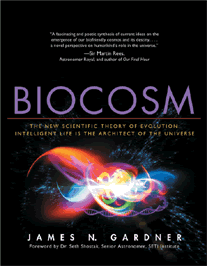 Biocosm - "The new scientific theory of evolution: intelligent life is the architect of the universe". Biocosm - "The new scientific theory of evolution: intelligent life is the architect of the universe". Why is the universe bio-friendly? Bioastronomy, once an intriguing and speculative sideline, has become a major focus for cosmologists. James N. Gardner presents a startling hypothesis for how our apparently bio-friendly universe began and what its ultimate destiny will be. Originally presented in peer-reviewed scientific journals, his radical “Selfish Biocosm” hypothesis proposes that life and intelligence have not emerged in a series of Darwinian accidents but are essentially hardwired into the cycle of cosmic creation, evolution, death, and rebirth. He argues that the destiny of highly evolved intelligence (perhaps our distant progeny) is to infuse the entire universe with life, eventually to accomplish the ultimate feat of cosmic reproduction by spawning one or more “baby universes,” which will themselves be endowed with life generating properties. In this explanation of the role of life in the cosmos, Gardner presents an eloquent and lucid synthesis of the most recent advances in physics, cosmology, biology, biochemistry, astronomy, and complexity theory. These disciplines increasingly find themselves approaching the frontier of what was once the exclusive province of philosophers and theologians. Gardner’s Selfish Biocosm hypothesis challenges both Darwinists and advocates of intelligent design, and forces us to reconsider how we ourselves are shaping the future of life and the cosmos. Ah, great!! Very refreshing that a science guy can get away with that, and manages to get it through peer-reviewed mine fields. The world must indeed be changing. And it is funny and ironic that science might end up in a roundabout way with such a spiritual view of life and the universe. I don't really care how it happens, but I'm all for it. Of course the universe is intelligent and inherently generating life. For that matter, that's the only view that can integrate science and spirituality. I've ordered the book.
[ Science | 2006-02-20 23:22 | | PermaLink ] More >
|
|
| Friday, October 21, 2005 |  |
|
|
|
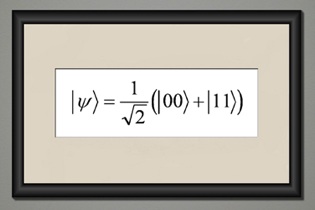 Justin Mullins collects beautiful equations. Well, some people think equations are beautiful. I don't know. But the description of this one is. It is about entanglement. Justin Mullins collects beautiful equations. Well, some people think equations are beautiful. I don't know. But the description of this one is. It is about entanglement.The connections between ordinary objects are fleeting and superficial. Two atoms may collide and separate, never to meet again. Others can stick together by virtue of the chemical bonds they form, until the day that bond is broken.
But there is another type of connection that is far more powerful and romantic. Certain objects can become linked by a mysterious process called entanglement. Particles that become entangled are deeply connected regardless of the distance between them. If they become separated by the width of the Universe, the bond between them remains intact. These particles are so deeply linked that it’s as if they somehow share the same existence.
Physicists do not yet fully understand the nature of entanglement but there is growing evidence that it is a fundamental property of the universe. Unfettered by the restrictions of space, entanglement may be the ghostly bedrock upon which reality is built.
Yeah, I love the beautiful stuff that physicists don't quite understand. Go entanglement! (via BoingBoing)
[ Science | 2005-10-21 23:06 | | PermaLink ] More >
|
|
| Friday, October 14, 2005 |  |
|
|
|
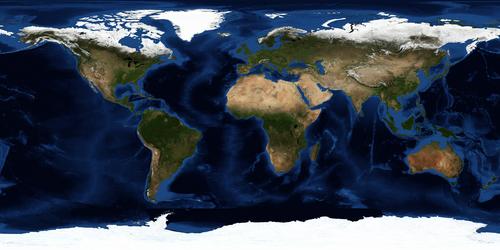
NASA has a new series of "Blue Marble" pictures of the Earth from space, composite pictures, completely without cloud cover. Many resolutions and versions, like here or here, and animations too.
[ Science | 2005-10-14 15:06 | | PermaLink ] More >
|
|
| Friday, April 15, 2005 |  |
|
|
|
 National Geographic has a program where you can submit a DNA sample and be told your genetic history, where your ancestors came from and how they have migrated. That would be fun to see. National Geographic has a program where you can submit a DNA sample and be told your genetic history, where your ancestors came from and how they have migrated. That would be fun to see.
10 years ago I worked as a computer programmer for a company that did testing for organ transplants. That wasn't primarily DNA testing, but serological testing. I.e. one tests reactions between different drops of blood, and one measures against HLA, Human Leukocyte Antigens, on a section of chromosome 6, which has characteristic markings, which happen to be useful for testing tissue compatibility. Anyway, they also showed me charts like that, where the different types had been tracked over time in different parts of the world, and migratory patterns revealed. And I got a kick out of that they frequently wanted my blood, because it apparently was tricky to type, so they would use it for verifying the correctness of some of their tests. It is nice to be special.
[ Science | 2005-04-15 22:17 | | PermaLink ] More >
|
|
| Saturday, February 19, 2005 |  |
|
|
|
ScienceBlog:Following the Asian tsunami, scientists struggled to explain reports that primitive aboriginal tribesmen had somehow sensed the impending danger in time to join wild animals in a life-saving flight to higher ground. A new theory suggests that the anterior cingulate cortex, described by some scientists as part of the brain's "oops" center, may actually function as an early warning system -- one that works at a subconscious level to help us recognize and avoid high-risk situations.
Cool, I didn't hear about the aboriginals sensing the tsunami. Anyway, good for the scientists if they can find some part of the brain that they can cut out and say "This is it!", so they don't have to get all nervous when people do stuff they're not supposed to.
[ Science | 2005-02-19 19:54 | | PermaLink ] More >
|
|
| Tuesday, February 15, 2005 |  |
|
|
|
 The Global Consciousness Project is getting some press recently. The Global Consciousness Project is getting some press recently. DEEP in the basement of a dusty university library in Edinburgh lies a small black box, roughly the size of two cigarette packets side by side, that churns out random numbers in an endless stream.
At first glance it is an unremarkable piece of equipment. Encased in metal, it contains at its heart a microchip no more complex than the ones found in modern pocket calculators.
But, according to a growing band of top scientists, this box has quite extraordinary powers. It is, they claim, the 'eye' of a machine that appears capable of peering into the future and predicting major world events.
The machine apparently sensed the September 11 attacks on the World Trade Centre four hours before they happened - but in the fevered mood of conspiracy theories of the time, the claims were swiftly knocked back by sceptics. But last December, it also appeared to forewarn of the Asian tsunami just before the deep sea earthquake that precipitated the epic tragedy.
Now, even the doubters are acknowledging that here is a small box with apparently inexplicable powers.
'It's Earth-shattering stuff,' says Dr Roger Nelson, emeritus researcher at Princeton University in the United States, who is heading the research project behind the 'black box' phenomenon.
'We're very early on in the process of trying to figure out what's going on here. At the moment we're stabbing in the dark.' Dr Nelson's investigations, called the Global Consciousness Project, were originally hosted by Princeton University and are centred on one of the most extraordinary experiments of all time. Its aim is to detect whether all of humanity shares a single subconscious mind that we can all tap into without realising.
It is simply a random number generator. It generates a lot of random ones and zeros. And a bunch of separate devices in different places do the same thing. And the thing is that the results are influenced by big global events. The numbers suddenly become less random and more coherent. And one can easily calculate how much they deviate from what they were "supposed" to be. And how unlikely that would be to be pure coincidence. And the fun thing is also that the results show a little before the actual events happen.
That isn't terribly strange, if we assume that everything is connected, and exists in the same unified quantum field. But it makes many scientists very nervous. Apparently they're becoming more comfortable with the idea, as the can't really get around the results, however much they try.
It isn't really worth much in predicting the future. All it shows is that something big is going on, or is going to happen shortly, which will be important to many people. But it gives no clue as to what it is going to be. So, mainly it probably serves to make consciousness something that science can't ignore. Which is a valuable aim in itself.
[ Science | 2005-02-15 15:39 | | PermaLink ] More >
|
|
| Monday, January 17, 2005 |  |
|
|
|
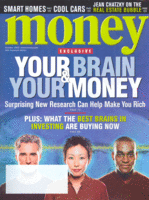 What is "neuroeconomics"? See the Neuroeconomics Blog What is "neuroeconomics"? See the Neuroeconomics BlogNeuroeconomics is an interdisciplinary research program with the goal of building a biological model of decision making in economic environments. Neuroeconomists ask, how does the embodied brain enable the mind (or groups of minds) to make economic decisions? By combining techniques from cognitive neuroscience and experimental economics we can now watch neural activity in real time, observe how this activity depends on the economic environment, and test hypotheses about how the emergent mind makes economic decisions. Neuroeconomics allows us to better understand both the wide range of heterogeneity in human behavior, and the role of institutions as ordered extensions of our minds.
Hm, I suppose that is interesting. Does the brain make economic decisions? To a large degree, I guess. You get stimulated in various ways, your inhibitions get lowered, and you buy. But that's probably where we'll find a lot of the somewhat irrational reasons for economic activity, in neurological patterns. Probably won't turn up that rational agent that free market capitalist theory pre-supposes.
Anyway, we can of course imagine going all the way with this. Your brain is constantly wired and our signals are networked. Our electronic agents will negotiate transactions based on how neurologically motivated you are by the objects in question. So, if you really, really want it, you pay more. And pretty soon your bank account will automatically be debited when you walk by a billboard advertising swim suits. If you like it, that is. If you train yourself to have no reaction to anything, by taking lots of prozac and depriving yourself of sleep, or whatever, you can save a lot of money, as you'd always get it for the cheapest possible price.
[ Science | 2005-01-17 16:46 | | PermaLink ] More >
|
|
|
|
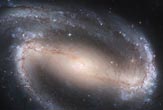 According to space.com, a group of scientists have realized that it is more likely than not that there are plenty of advanced extraterrestrial civilizations around, and that maybe they ought to start investigating some of the many well-documented reports of their visits, rather than just sitting listening for radio signals from them. According to space.com, a group of scientists have realized that it is more likely than not that there are plenty of advanced extraterrestrial civilizations around, and that maybe they ought to start investigating some of the many well-documented reports of their visits, rather than just sitting listening for radio signals from them.
Duh, is that so hard to figure out? Yes, it apparently it is, as it traditionally have been very unpopular amongst serious scientists to pay any attention to UFO reports. Or, stronger than that, it would be a blemish on their careers and reputations if they even were caught considering that anybody might be visiting us. So, instead they've been stuck on the somewhat questionable theory that billion year advanced civilizations would be sending radio shows in our direction, which we might catch on the dial.
Anyway, this new thinking doesn't seem so much a result of being impressed with the considerable body of existing evidence, as it is a result of the growing realization that science might actually support some models for how one might get around in space. So, you know, only start looking once you have a theory that says there might be something there. Don't look just because there's something there.Given billion-year advanced physics, might not buzzing around the galaxy be possible?
Even today superstring theory hypothesizes other dimensions... which could be habitable Universes adjacent to our own, the researchers speculate. It might even be possible to get around the speed of light limit by moving in and out of these dimensions.
"What we have done is somewhat of a breakthrough," Haisch told SPACE.com. "We have pulled together various recent discoveries and theoretical issues that collectively point to the strong probability that we should be in the midst of one or more huge extraterrestrial civilizations," he said.
Haisch said that superstring dimensions and wormhole and spacetime stretching possibilities address the "can't get here from there" objection often argued in view of the interstellar, point-to-point distances involved. Also, diffusion models predict that even a single civilization could spread across the Galaxy in a tiny fraction of the age of the Galaxy - even at sub-light speeds, he said.
Of course you might still find scientific types who hold on to the 100 year old idea that nobody can get anywhere faster than the speed of light, so it is all impossible nonsense that anobody would be visiting anybody. But the winds are changing.
[ Science | 2005-01-17 16:16 | | PermaLink ] More >
|
|
| Monday, January 10, 2005 |  |
|
|
|
 Edge posted this question to a bunch of smart people: "What do you believe is true even though you cannot prove it?" Which is a great question to ask, and particularly interesting to ask of scientific types who often try to insist they only believe things they can prove. Edge posted this question to a bunch of smart people: "What do you believe is true even though you cannot prove it?" Which is a great question to ask, and particularly interesting to ask of scientific types who often try to insist they only believe things they can prove.
Now, at first I thought it was just going to be some inspiring things to quote from. But there are some interesting subtexts going through most of the answers. You know, most of these guys are materialist atheists. But yet the red thread that goes through all of them is *consciousness*. A bunch of them quickly move to very dogmatically declaring that there's no God, no design to the universe, and everything is just the result of random accidents. They seem very convinced of that. But of course they indeed are answering the question, because they can't prove it, and they know it. Another bunch of them make very hopeful declarations of being very sure that it is "just around the corner" that we'll discover what part of the brain consciousness comes from and how it works, and we'll able to duplicate it in computers or the like. And implicitly admitting that such things aren't in any way proven, and nobody actually have done so. But, again, they seem very sure of it. And, indeed, most of them are practically squirming and bending over backwards to try to make the case for what is essentially a negative belief. That there's no consciousness and anything that can't be proven in a materialistic sense is just stupid supersticious nonsense. Oh, none of them actually say there's no consciousness, but they wrap it up in it just being an illusion or some phenomenon that happens late in the evolutionary process or some chemical neuro-physiological phenomenon.
Quite remarkable, to see the amount of fear that is stirred up, and the convoluted beliefs that people construct in order to avoid the more simple and unified answers. And the peer pressure that obviously must exist amongst scientists, to look and sound scientific and objective at all times, even when the truth is that you can't really prove very much about anything.
Anyway, there are still many inspiring statements there, and a few of them aren't just hiding behind negative dogma. So, here are a few I liked:Anton Zeilinger:"What I believe but cannot prove is that quantum physics teaches us to abandon the distinction between information and reality. The fundamental reason why I believe in this is that it is impossible to make an operational distinction between reality and information. In other words, whenever we make any statement about the world, about any object, about any feature of any object, we always make statements about the information we have. And, whenever we make scientific predictions we make statements about information we possibly attain in the future."
Paul Steinhardt: "I believe that our universe is not accidental, but I cannot prove it. Historically, most physicists have shared this point-of-view. For centuries, most of us have believed that the universe is governed by a simple set of physical laws that are the same everywhere and that these laws derive from a simple unified theory."
Gregory Benford: "Why is there scientific law at all? We physicists explain the origin and structure of matter and energy, but not the laws that do this. Does the idea of causation apply to where the laws themselves came from? Even Alan Guth's "free lunch" gives us the universe after the laws start acting. We have narrowed down the range of field theories that can yield the big bang universe we live in, but why do the laws that govern it seem to be constant in time, and always at work? One can imagine a universe in which laws are not truly lawful. Talk of miracles does just this, when God is supposed to make things work. Physics aims to find The Laws and hopes that these will be uniquely constrained, as when Einstein wondered if God had any choice when He made the universe."
Alison Gopnik: "I believe, but cannot prove, that babies and young children are actually more conscious, more vividly aware of their external world and internal life, than adults are. I believe this because there is strong evidence for a functional trade-off with development. Young children are much better than adults at learning new things and flexibly changing what they think about the world. On the other hand, they are much worse at using their knowledge to act in a swift, efficient and automatic way. They can learn three languages at once but they can't tie their shoelaces."
Lynn Margulis: "That our ability to perceive signals in the environment evolved directly from our bacterial ancestors. That is, we, like all other mammals including our apish brothers detect odors, distinguish tastes, hear bird song and drum beats and we too feel the vibrations of the drums. With our eyes closed we detect the light of the rising sun. These abilities to sense our surroundings are a heritage that preceded the evolution of all primates, all vertebrate animals, indeed all animals. Such sensitivities to wafting plant scents, tasty salted mixtures, police cruiser sirens, loving touches and star light register because of our "sensory cells"."
Mihaly Csikzentmihalyi: "When I first read your question, I was sure it was a trick—after all, almost nothing I believe in I can prove. I believe the earth is round, but I cannot prove it, nor can I prove that the earth revolves around the sun or that the naked fig tree in the garden will have leaves in a few months. I can't prove quarks exist or that there was a Big Bang—all of these and millions of other beliefs are based on faith in a community of knowledge whose proofs I am willing to accept, hoping they will accept on faith the few measly claims to proof I might advance."
Randolphe Nesse: "I can't prove it, but I am pretty sure that people gain a selective advantage from believing in things they can't prove. I am dead serious about this. People who are sometimes consumed by false beliefs do better than those who insist on evidence before they believe and act. People who are sometimes swept away by emotions do better in life than those who calculate every move. These advantages have, I believe, shaped mental capacities for intense emotion and passionate beliefs because they give a selective advantage in certain situations."
Douglas Rushkoff: "I can't prove it more than anecdotally, but I believe evolution has purpose and direction. It appears obvious, yet absolutely unconfirmable, that matter is groping towards complexity."
But the only one that actually wasn't afraid of believing in consciousness is this guy:Donald Hoffman: "I believe that consciousness and its contents are all that exists. Spacetime, matter and fields never were the fundamental denizens of the universe but have always been, from their beginning, among the humbler contents of consciousness, dependent on it for their very being.
The world of our daily experience—the world of tables, chairs, stars and people, with their attendant shapes, smells, feels and sounds—is a species-specific user interface to a realm far more complex, a realm whose essential character is conscious. It is unlikely that the contents of our interface in any way resemble that realm. Indeed the usefulness of an interface requires, in general, that they do not. For the point of an interface, such as the windows interface on a computer, is simplification and ease of use. We click icons because this is quicker and less prone to error than editing megabytes of software or toggling voltages in circuits. Evolutionary pressures dictate that our species-specific interface, this world of our daily experience, should itself be a radical simplification, selected not for the exhaustive depiction of truth but for the mutable pragmatics of survival.
If this is right, if consciousness is fundamental, then we should not be surprised that, despite centuries of effort by the most brilliant of minds, there is as yet no physicalist theory of consciousness, no theory that explains how mindless matter or energy or fields could be, or cause, conscious experience."
Right. And that is to a large degree what I get from the eloquent statements of most of these other prominent folks I'm not quoting. They have failed to come up with any reasonable explanation, let alone proof, as to how mindless matter accidentally develops consciousness, or how a beautiful and very functional system of natural laws and evolution of life emerges by mere accident. They have no proof, so they make long explanations to try to delay that realization, and most of all they BELIEVE strongly that they're right, so they are willing to continue to the bitter end without any shred of evidence for that which they believe in.
[ Science | 2005-01-10 20:43 | | PermaLink ] More >
|
|
| Sunday, January 9, 2005 |  |
|
|
|
 Nature via Slashdot, talks about "Quantum Darwinism": Nature via Slashdot, talks about "Quantum Darwinism":"If, as quantum mechanics says, observing the world tends to change it, how is it that we can agree on anything at all? Why doesn't each person leave a slightly different version of the world for the next person to find? Because, say the researchers, certain special states of a system are promoted above others by a quantum form of natural selection, which they call quantum darwinism. Information about these states proliferates and gets imprinted on the environment. So observers coming along and looking at the environment in order to get a picture of the world tend to see the same 'preferred' states. researchers suggest in Physical Review Letters, the world would be very unpredictable: different people might see very different versions of it. Life itself would then be hard to conduct, because we would not be able to obtain reliable information about our surroundings... it would typically conflict with what others were experiencing."
Connecting that up with Darwinism sounds a little silly, I'd say. Seems perfectly obvious to me. That the Buckingham Palace has the same number of windows whenever you look at it is not because some little quantum thingies are fighting it out, and the state we see is what came out the strongest. Rather, they need to really get the thing about what you observe being a result of how it is observed. Looking straight at something isn't the only way of observing it. A great many people have observed the Buckingham Palace very carefully over time, and have taken pictures of it, written books about it, etc. In the bigger scheme of things, they're all observing it. It is a simple matter of averages, and maybe of a power law. If the majority of people believe it to be in that particular state (its location, color, construction, number of windows, etc), then that's what you're likely to find, if you don't manage to make the extra effort to find some drastically different way of looking at it. Picasso might have seen it rather differently, no matter what anybody else thought. But most people are pre-disposed to seeing it the way it "is", which means largely the way that the majority of everybody else has seen it. In part because the majority opinion reinforces itself. Nothing to do with darwinism between quantum particles. Maybe natural selection within the attention from observers. If millions of people are seeing it a certain way, whether they happen to be there at the moment or not, and that way works, and is consistent with its surroundings and perceived history, then that's what you're likely to see too. Shouldn't be that hard to figure out. But this is still so strange to anybody who, despite any advances in quantum physics, still thinks about things in a newtonian manner. So they might look for more convoluted ways of figuring it out.
[ Science | 2005-01-09 12:40 | | PermaLink ] More >
|
|
| Monday, December 20, 2004 |  |
|
|
|
 ABC News: ABC News:A millionaire activist who believes the September 11 terrorist attacks in 2001 were and "inside job" is offering a $130,000 reward to anyone who can prove him wrong.
Jimmy Walter has spent more than $3.9 million promoting the conspiracy theory and is offering the reward to any engineering student who can prove the World Trade Centre buildings crashed the way the Government says they did.
"Of course, we expect no winners," Mr Walter, 57, heir to an $14.3 million fortune from his father's home-building business.
He accuses figures in government, the military and business of involvement in the September 11 attacks.
Mr Walter says a panel of expert engineers will judge submissions from the students.
Notice, the award is for proving the official story. You know, planes hit the buildings and the burning jet fuel softened the steel, so they collapsed. Should be easy money for any engineering student to lay out the calculations, no? The problem with that is unfortunately that what officially happened doesn't seem to fit with any known laws of physics, so, aye, there's the rub. Which one is the theory, now? I don't think anybody will claim the reward. And neither is the mass media going to lose any sleep over that.
[ Science | 2004-12-20 18:24 | | PermaLink ] More >
|
|
| Monday, November 15, 2004 |  |
|
|
|
 Via Bird on the Moon, this is an abstract from an article, Omega Zero; The Influence of the Future on Cosmic Evolution: Via Bird on the Moon, this is an abstract from an article, Omega Zero; The Influence of the Future on Cosmic Evolution: In considering the recent discovery that cosmological expansion is accelerating toward the extreme physics of absolute zero, science is understandably at a loss for conceptual representation of the distant future. Cosmology is in an unprecedented adjustment period since the absolute zero future we are being forced to consider was previously ruled impossible. Part one of this essay considers the consequences of admitting absolute zero as a possible state in the partition of states considered available to the evolution of space-time, and considers reasons why reaching zero might be the overall objective of time. In investigating the role of zero within the set of all possible states we recognize that if the direction of time is indeed aimed at zero, then the second law of thermodynamics is too simple to explain time’s arrow. Part two, in considering how an absolute zero state fits into an order-disorder gradient, proposes the central theme of the paper, a theory that there are two opposing types of order present in nature, rather than simply order and disorder, a step which directly challenges the second law in a general way not considered previously. The concrete discovery of two orders resolves into focus a major conceptual shift first advocated in western science by physicist David Bohm. It exposes a supreme state in physical reality and leads to a teleological model of cosmological and biological evolution. In support of this shift, part three presents a surprising switch in mathematical modality, what one reader referred to as God’s math, where positive and negative numbers, or matter and anti-matter, are understood to combine rather than cancel, making absolute zero a unified whole value, rather than nothing. This essay introduces several valuable and highly thought provoking fundamental concepts which, like the anthropic principle prior to 1974, have not yet been explored in mainstream science. Can't say I exactly get it, but count me in.
[ Science | 2004-11-15 02:07 | 0 comments | PermaLink ]
|
|
| Monday, May 10, 2004 |  |
|
|
|
 From FutureHi, abstract of paper, "What is Natural Selection? A Plea for Clarification", by Neil Broom: From FutureHi, abstract of paper, "What is Natural Selection? A Plea for Clarification", by Neil Broom:I argue in this paper that any evolutionary theory of life that excludes from the living world a primary non-material or transcendent dimension or guiding presence, is no theory at all. The materialist's claim that natural selection supplies this evolutionary 'arrow' but is entirely material in its action, is a fundamentally dishonest claim. If there is no real purposive agenda that natural selection is pursuing then the expression "natural selection" is blatantly misleading and should be deleted from the evolutionary vocabulary. The paper is very readable and absolutely brilliantly argued, I think. He's right. Materialist neo-darwinism is a bunch of superstituous crap. Well, those are my words. It mostly consists of skipping over the evidence and bending over backwards to try to prove with mere words that life is based on a completely blind and unconscious and random process, and there's no purpose to anything. But that gets a little silly when you try to explain how things that do have a purpose come about. There are no half-eyes or half-flying animals or birds that are half laying eggs that sort of half have unborn chicks inside. Explaining how amazingly complex organs like eyes come about, or how animals end up flying through the air, all by miniscule and completely random accidents, requires arguing in circles for quite a while, until the reader sort or gives up, or decides he agrees with you. It is pretty much the same approach as in Creationism, just with the use of a sort of Anti-God, called Unconscious Randomness. Becomes just as silly as trying to explain that a God decided to create humans out of mud. Or that it is turtles all the way down. Anyway, I'm ranting. Neil Broom argues much more soberly and provides plenty of reference material.
And here, via Frank Patrick's Focused Performance Blog, is a quote from Agent(s) Smith in Matrix Reloaded: "Without purpose, we would not exist. It is purpose that created us, purpose that connects us, purpose that pulls us, that guides, that drives us. It is purpose that defines us, purpose that binds us."
[ Science | 2004-05-10 15:56 | | PermaLink ] More >
|
|
| Thursday, April 15, 2004 |  |
|
|
|
 News item about a substance, NOVEC 1230, that looks like water and acts somewhat like water, except for that it isn't wet, and anything you submerge into it doesn't get wet. This company uses it for firefighting purposes, and apparently it was developed by 3M. You can sprinkle it out over computers and papers and everything, and it puts out fire as well as water, but the items don't get damaged. As a matter of fact, you can apparently drop a book or a running computer into the stuff, and the book doesn't get wet, and the computer keeps running. News item about a substance, NOVEC 1230, that looks like water and acts somewhat like water, except for that it isn't wet, and anything you submerge into it doesn't get wet. This company uses it for firefighting purposes, and apparently it was developed by 3M. You can sprinkle it out over computers and papers and everything, and it puts out fire as well as water, but the items don't get damaged. As a matter of fact, you can apparently drop a book or a running computer into the stuff, and the book doesn't get wet, and the computer keeps running.
Give us some cool pictures, dammit. Looking at those company websites makes it sound much more boring.
[ Science | 2004-04-15 11:51 | | PermaLink ] More >
|
|
| Wednesday, March 24, 2004 |  |
|
|
|
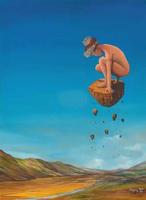 Paul Hughes has an excellent article on FutureHi, "Defending Psychic Experience", arguing for the fundamental validity of inner experience, and discussing the difficulty in providing "objective scientific proof" for the same. Which gives rise to the various kinds of heated discussions that can happen between people who address the subject from different angles. Paul Hughes has an excellent article on FutureHi, "Defending Psychic Experience", arguing for the fundamental validity of inner experience, and discussing the difficulty in providing "objective scientific proof" for the same. Which gives rise to the various kinds of heated discussions that can happen between people who address the subject from different angles.[S]ince objective reductionist science has served us so well, so unbelievable well, it's become an addiction we can't let go of when it fails. Rather than blame objectivity itself, we instead say that anything that cannot be objectively verified is false. Which is why it comes as no surprise that many leading thinkers in the fields of cognitive and neuro-science actually believe that the inner experience is an illusionary falsity that doesn't exist!
This is where most often any further dialog on the subject comes to a grinding screeching halt. Because now they are resting on dogma. And once dogma enters the picture, there is no way to have a reasonable disucssion going forward. The basic assumptions are so different (i.e those who say they have an inner experience, and those saying it is doesn't exist), that dialog going forward becomes almost impossible. The same as if you were to argue about if God exists or not with an fundamentalist Christian. For those of you who've tried, you will understand what I mean by this. Yeah, I've tried arguing with various kinds of fundamentalists, and also with materialist fundamentalists, so I understand very well what he means. This is what I wrote in a comment:It is kind of a weird situation: arguing with people who believe they don't really exist, but that they nevertheless are right. To me, practices such as science and reasoning have to be based on a firm foundation of what you irrefutably can know by personal observation. Just about the only thing I know for sure is that I exist and that I perceive and think. The rest is guesswork which always will build on those primary factors, but it might be very useful guesswork if you don't lose your way. If somebody else decides to instead start off with some abstract theory, and they end up concluding that I don't exist, then I'd say they've done a bad job of reasoning, largely by starting in some arbitrary place, with data that they can't prove. This argument is an important one to me. I must admit that I once in a while write a long article about it, and half the time I don't post it. Because in reality I don't have the argument in person very often. I.e. an argument with a Fundamentalist Materialist Skeptic about the validity of subjective experience, particularly as it pertains to "psychic" phenomena of any kind. And it seems sort of strange to have a heated argument with somebody who isn't there. So I usually decide against posting it.
Anyway, from another comment to Paul's article comes a link to an absolutely excellent paper by Neal Grossman, Dept. of Philosophy, Univ. of Illinois at Chicago: "On Materialism as Science Dogma". He makes the arguments better than any of us could hope to do. Long and very readable article. He chooses to use NDE (Near Death Experiences) as a reference point, but as he says, it could well be about UFOs or a bunch of other "weird" subjects that happen to be extremely well documented and scientifically verified, but still generally ridiculed by both materialist and religious fundamentalists, who still, maybe for a while longer, are the ones with the most say and the most power in academics, in government, and, somewhat, in the media.Fundamaterialism is so deeply ingrained in the academic establishment that most researchers on the NDE fall prey to it. For, after presenting case after case which would satisfy any reasonable standard of empirical evidence against materialism, even sympathetic researchers almost always deem it necessary to add the disclaimer that their research does not prove that there is life after death. But no scientific hypothesis is ever proven in this sense. Theorems in logic and mathematics can be proved. In science, hypotheses are not proved; rather, empirical evidence renders a given hypothesis more or less probable. There is no such thing as logical, or mathematical certainty in science. The fundamaterialists are correct in that the hypothesis that consciousness exists independently of the body cannot be proven with mathematical certainty. But neither can any other scientific hypothesis, because empirical science deals with evidence, not proof. Evidence never "proves" a hypothesis, it just makes it more probable. And, when evidence for a given hypothesis accumulates to a certain degree, we accept the hypothesis as true. But "true" in this scientific sense never means "proven"; it means very very probable. In science there is always the possibility that a given hypothesis may turn out to be false. The fundamaterialist will not accept the hypothesis of an afterlife until it is "proven" beyond a logical possibility of being false. That is, he is using a concept of proof which belongs in logic and mathematics, not in science. And NDE researchers are playing the fundamaterialist's game when they utter caveats that their research does not prove the hypothesis of an afterlife. What researches should say, in my opinion, is simply that they have amassed sufficient evidence to render the hypothesis of an afterlife very probable, and the hypothesis of materialism very improbable.
In the above paragraphs, I have been using the terms "science" and "scientific" in its epistemological sense. Science is a methodological process of discovering truths about reality. Insofar as science is an objective process of discovery, it is, and must be, metaphysically neutral. Insofar as science is not metaphysically neutral, but instead weds itself to a particular metaphysical theory, such as materialism, it cannot be an objective process for discovery. There is much confusion on this point, because many people equate science with materialist metaphysics, and phenomena which fall outside the scope of such metaphysics, and hence cannot be explained in physical terms, are called "unscientific". This is a most unfortunate usage of the term. For if souls and spirits are in fact a part of reality, and science is conceived epistemologically as a systematic investigation of reality, then there is no reason why science cannot devise appropriate methods to investigate souls and spirits. But if science is defined in terms of materialist metaphysics, then, if souls and spirits are real, science, thus defined, will not be able to deal with them. But this would be, not because souls and spirits are unreal, but rather because this definition of science (in terms of materialist metaphysics) has semantically excluded nonphysical realities from it scope. So, obviously it is hard to discuss a subject matter with somebody who has the fundamental, unshakable belief that it doesn't exist at all and that it is impossible. Like my comment above about the difficulty of discussing existence and inner experience with a person who believes that they don't really exist.
I believe it will all turn around, and before very long. And that will change our lives and our societies immensely. We might indeed find that we can very well understand a large chunk of life, the universe and everything - material as well as non-material - inner as well as outer, and we can understand all of that in a rather unified and very rational way. And we might realize that we had been lead astray from time to time by high priests who made us believe they had a direct line in with universal truth, when really they were just listening to their own voices in their own heads. Which will all be quite forgivable at that time. It is a noble and formidable goal to try to understand how existence works, and not hard to get stuck in a blind alley along the way.
[ Science | 2004-03-24 01:05 | | PermaLink ] More >
|
|
| Tuesday, February 24, 2004 |  |
|
|
|
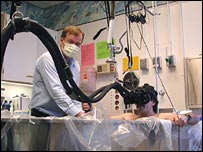 BBC Article talks about how a doctor in a burn center in a hospital in Seattle has had great success using Virtual Reality to help burn victims not feel so much pain. BBC Article talks about how a doctor in a burn center in a hospital in Seattle has had great success using Virtual Reality to help burn victims not feel so much pain.Hoffman's virtual worlds, which he calls by names such as SnowWorld or SpiderWorld, are designed to immerse the user so deeply in the virtual experience that their attention is distracted away from the pain.
SnowWorld, for instance, takes users on an absorbing virtual journey through glaciers and ice caves whilst having to defend themselves from attack by polar bears and penguins.
Mike Robinson, a patient who has undergone the virtual reality treatment, said it helped him to overcome the extreme discomfort he felt when his dressings were changed.
"My pain when the nurse is changing my bandages is consistently extreme," he told BBC News Online. "But during the time I was in VR, I was pretty much unaware that the nurse was even working on my wound. "I mean, at some level I knew she was working on me, but I wasn't thinking about it because I was inside that SnowWorld." That's pretty brilliant. And it goes on to touch on brain chemistry and neurology as to why that might be. Well, another way of looking at it could simply be that you aren't feeling pain if you aren't "in your body". So, if you aren't a fakir who can have an out-of-body experience at will, putting most of your attention into exploring a VR game is obviously a very practical idea. And there's this great quote from the doctor."Pain requires conscious attention. Humans have a limited amount of this and it's hard to do two things at once," Yeah, particularly if you're a man.
[ Science | 2004-02-24 17:32 | | PermaLink ] More >
|
|
| Sunday, February 22, 2004 |  |
|
|
|
Via Sounding Circle, from Reuters, news of how researchers are beginning to understand how plants manage to split water molecules into hydrogen and oxygen."Results by other groups, including those obtained using lower resolution x-ray crystallography at 3.7 angstroms, have shown that the splitting of water occurs at a catalytic center that consists of four manganese atoms," said So Iwata of Imperial's Department of Biological Sciences.
"We've taken this further by showing that three of the manganese atoms, a calcium atom, and four oxygen atoms form a cubelike structure, which brings stability to the catalytic center," Iwata added in a statement. "Together this arrangement gives strong hints about the water-splitting chemistry." Single cells found in plants or animals, or by themselves as bacteria have for billions of years mastered some clever nano-technology tricks which we'd obviously love to duplicate.
[ Science | 2004-02-22 17:56 | 0 comments | PermaLink ]
|
|
<< Newer stories Page: 1 2 3 4 Older stories >> |

